【Go】gin源码分析
点击阅读更多查看文章内容
转载:https://zhuanlan.zhihu.com/p/611116090
Gin的优势
- 支持中间件操作( handlersChain 机制 )
- 更方便的使用( gin.Context )
- 更强大的路由解析能力( radix tree 路由树 )
Gin与HTTP的关系
Gin 是在 Golang HTTP 标准库 net/http 基础之上的再封装,两者的交互边界如下图:
在 net/http 的既定框架下,gin 所做的是提供了一个 gin.Engine 对象作为 Handler 注入net/http其中,从而实现路由注册/匹配、请求处理链路的优化.
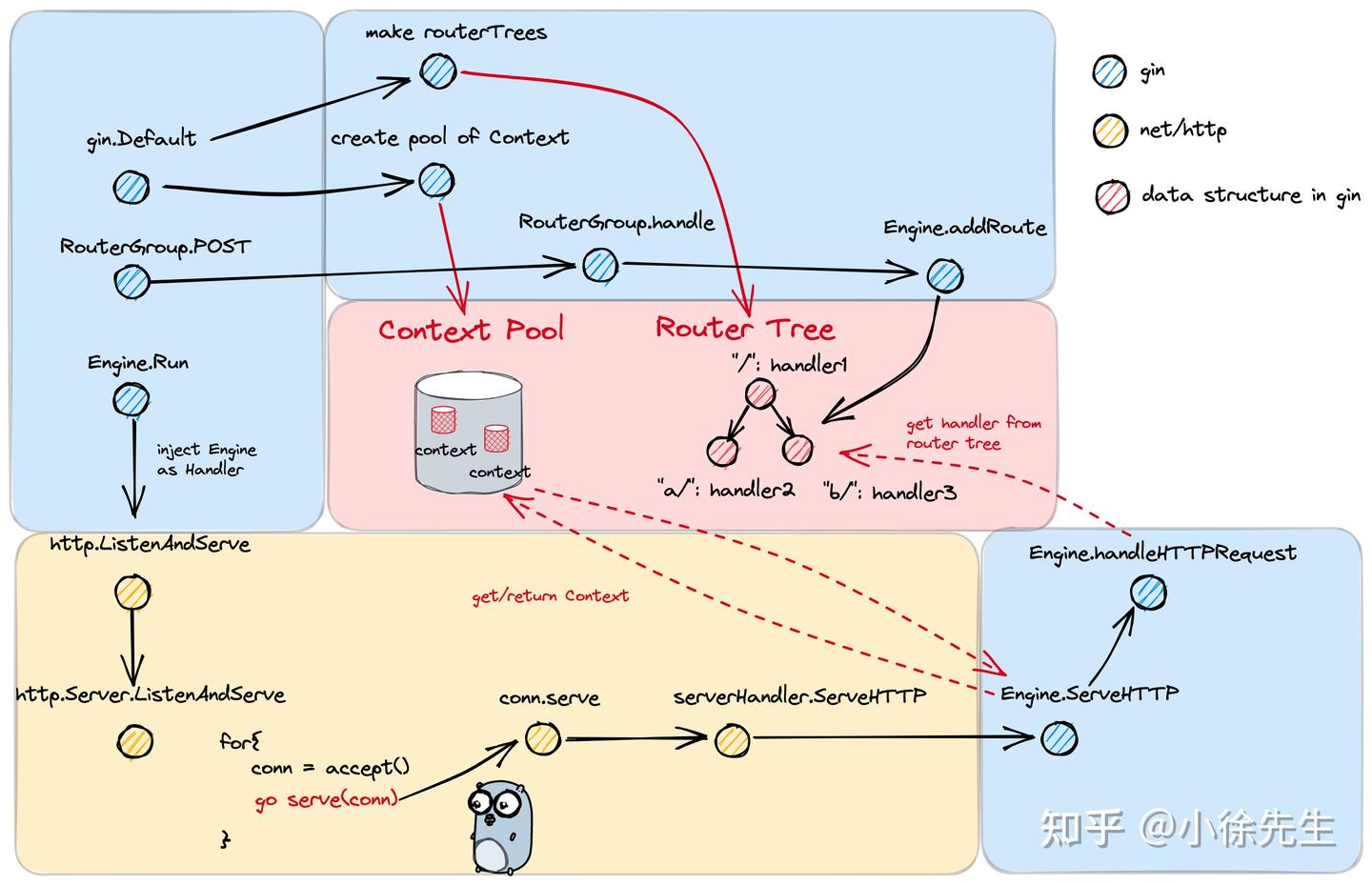
使用示例:
1 | func myMiddleWare(c *gin.Context) { |
核心数据结构
gin.Engine:Engine 为 Gin 中构建的 HTTP Handler,其实现了 net/http 包下 Handler interface 的抽象方法: Handler.ServeHTTP
1 | type Handler interface { |
因此可以作为 Handler 注入到 net/http 的 Server 当中.
1 | type Engine struct { |
Engine包含的核心内容包括:
- 路由组 RouterGroup:第(2)部分展开
- Context 对象池 pool:基于 sync.Pool 实现,作为复用 gin.Context 实例的缓冲池. gin.Context 的内容于本文第 5 章详解
- 路由树数组 trees:共有 9 棵路由树,对应于 9 种 http 方法. 路由树基于压缩前缀树实现,于本文第 4 章详解.
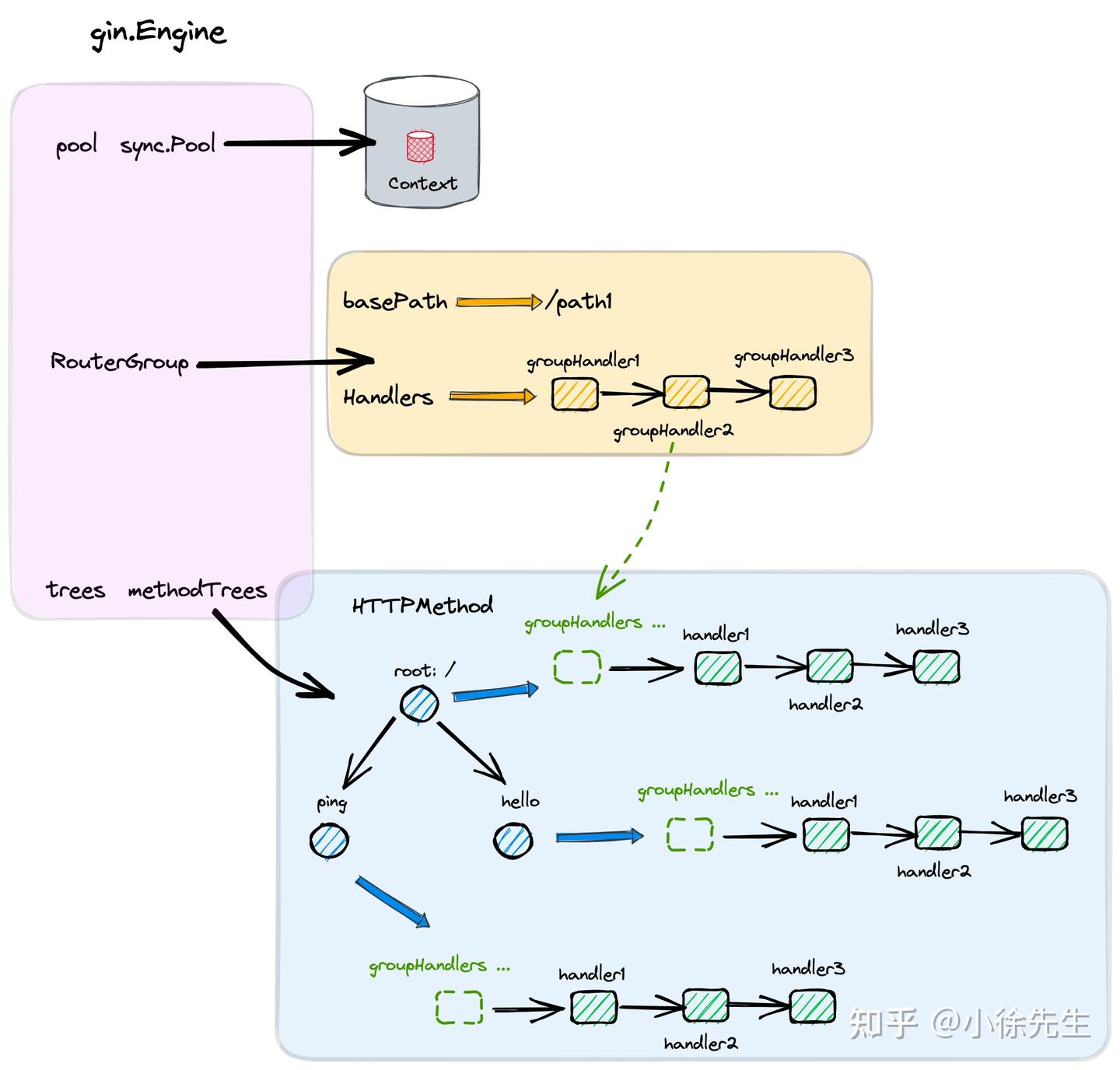
RouteGroup
1 | type RouterGroup struct { |
RouterGroup 是路由组的概念,其中的配置将被从属于该路由组的所有路由复用:
- Handlers:路由组共同的 handler 处理函数链. 组下的节点将拼接 RouterGroup 的公用 handlers 和自己的 handlers,组成最终使用的 handlers 链
- basePath:路由组的基础路径. 组下的节点将拼接 RouterGroup 的 basePath 和自己的 path,组成最终使用的 absolutePath
- engine:指向路由组从属的 Engine
- root:标识路由组是否位于 Engine 的根节点. 当用户基于 RouterGroup.Group 方法创建子路由组后,该标识为 false
HandlersChain
1 | type HandlersChain []HandlerFunc |
HandlersChain 是由多个路由处理函数 HandlerFunc 构成的处理函数链. 在使用的时候,会按照索引的先后顺序依次调用 HandlerFunc.
handler注册流程
下面以创建 gin.Engine 、注册 middleware 和注册 handler 作为主线,进行源码走读和原理解析:
1 | func main() { |
初始化 Engine
方法调用:gin.Default -> gin.New
- 创建一个 gin.Engine 实例
- 创建 Enging 的首个 RouterGroup,对应的处理函数链 Handlers 为 nil,基础路径 basePath 为 “/“,root 标识为 true
- 构造了 9 棵方法路由树,对应于 9 种 http 方法
- 创建了 gin.Context 的对象池
1 | func Default() *Engine { |
注册 middleware
通过 Engine.Use 方法可以实现中间件的注册,会将注册的 middlewares 添加到 RouterGroup.Handlers 中. 后续 RouterGroup 下新注册的 handler 都会在前缀中拼上这部分 group 公共的 handlers
1 | func (engine *Engine) Use(middleware ...HandlerFunc) IRoutes { |
注册 handler
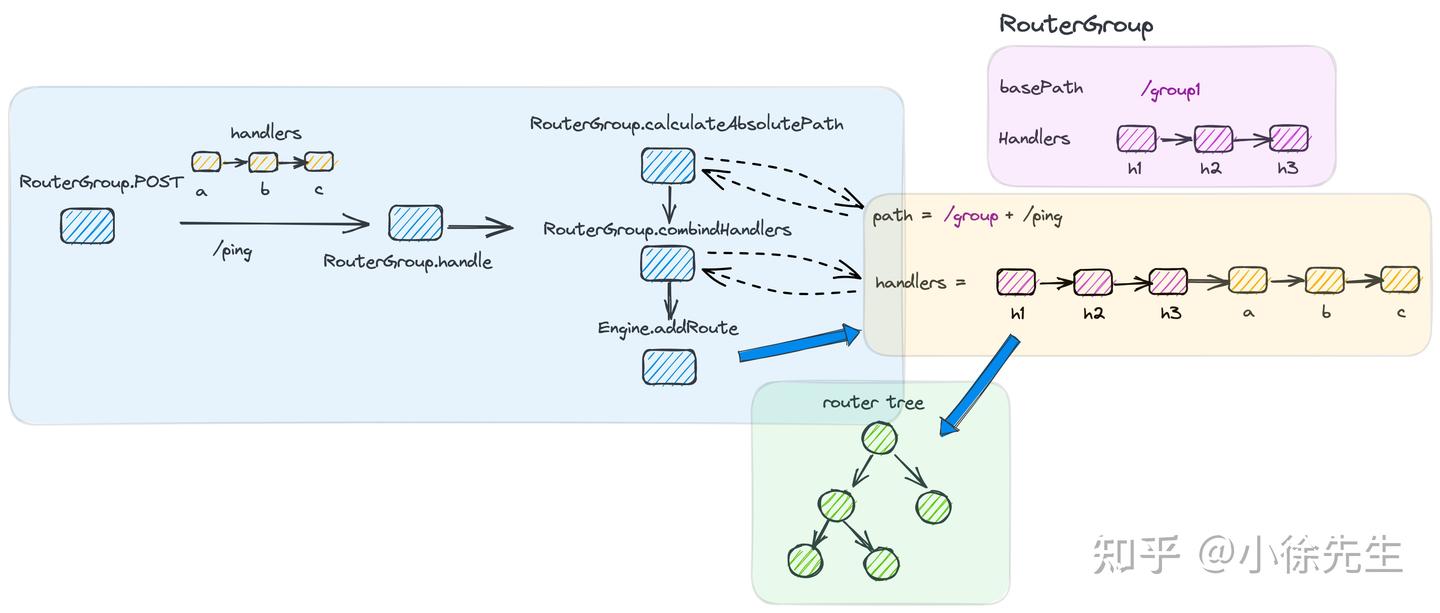
以 http post 为例,注册 handler 方法调用顺序为 RouterGroup.POST-> RouterGroup.handle,接下来会完成三个步骤:
- 拼接出待注册方法的完整路径 absolutePath
- 拼接出代注册方法的完整处理函数链 handlers
- 以 absolutePath 和 handlers 组成 kv 对添加到路由树中
1 | func (group *RouterGroup) POST(relativePath string, handlers ...HandlerFunc) IRoutes { |
服务端启动流程
流程入口:
下面通过 Gin 框架运行 http 服务为主线,进行源码走读:
1 | func main() { |
启动服务:
一键启动 Engine.Run 方法后,底层会将 gin.Engine 本身作为 net/http 包下 Handler interface 的实现类,并调用 http.ListenAndServe 方法启动服务.(ListenerAndServe 方法本身会基于主动轮询 + IO 多路复用的方式运行)
1 | func (engine *Engine) Run(addr ...string) (err error) { |
处理请求
在服务端接收到 http 请求时,会通过 Handler.ServeHTTP 方法进行处理. 而此处的 Handler 正是 gin.Engine,其处理请求的核心步骤如下:
- 对于每笔 http 请求,会为其分配一个 gin.Context,在 handlers 链路中持续向下传递
- 调用 Engine.handleHTTPRequest 方法,从路由树中获取 handlers 链,然后遍历调用
- 处理完 http 请求后,会将 gin.Context 进行回收. 整个回收复用的流程基于对象池管理
1 | func (engine *Engine) ServeHTTP(w http.ResponseWriter, req *http.Request) { |

Engine.handleHTTPRequest 方法核心步骤分为三步:
- 根据 http method 取得对应的 methodTree
- 根据 path 从 methodTree 中找到对应的 handlers 链
- 将 handlers 链注入到 gin.Context 中,通过 Context.Next 方法按照顺序遍历调用 handler
gin路由树

路由树是使用压缩前缀树实现的
(1)前缀树
前缀树又称 trie 树,是一种基于字符串公共前缀构建索引的树状结构,核心点包括:
- 除根节点之外,每个节点对应一个字符
- 从根节点到某一节点,路径上经过的字符串联起来,即为该节点对应的字符串
- 尽可能复用公共前缀,如无必要不分配新的节点
(2)压缩前缀树
压缩前缀树又称基数树或 radix 树,是对前缀树的改良版本,优化点主要在于空间的节省,核心策略体现在:
倘若某个子节点是其父节点的唯一孩子,则与父节点进行合并
在 gin 框架中,是用压缩前缀树
(3)为什么使用压缩前缀树
与压缩前缀树相对的就是使用 hashmap,以 path 为 key,handlers 为 value 进行映射关联,这里选择了前者的原因在于:
- path 匹配时不是完全精确匹配,比如末尾 ‘/’ 符号的增减(/ping与/ping/应该是同一个路径)、全匹配符号 ‘*’ 的处理等,map 无法胜任(模糊匹配部分的代码于本文中并未体现,大家可以深入源码中加以佐证)
- 路由的数量相对有限,对应数量级下 map 的性能优势体现不明显,在小数据量的前提下,map 性能甚至要弱于前缀树
- path 串通常存在基于分组分类的公共前缀,适合使用前缀树进行管理,可以节省存储空间
(4)补偿策略
在 Gin 路由树中还使用一种补偿策略,在组装路由树时,会将注册路由句柄数量更多的 child node 摆放在 children 数组更靠前的位置.
这是因为某个链路注册的 handlers 句柄数量越多,一次匹配操作所需要话费的时间就越长,被匹配命中的概率就越大,因此应该被优先处理.
Gin.Context

gin.Context 的定位是对应于一次 http 请求,贯穿于整条 handlersChain 调用链路的上下文,其中包含了如下核心字段:
- Request/Writer:http 请求和响应的 reader、writer 入口
- handlers:本次 http 请求对应的处理函数链
- index:当前的处理进度,即处理链路处于函数链的索引位置
- engine:Engine 的指针
- mu:用于保护 map 的读写互斥锁
- Keys:缓存 handlers 链上共享数据的 map
1 | type Context struct { |
复用
gin.Context 作为处理 http 请求的通用数据结构,不可避免地会被频繁创建和销毁. 为了缓解 GC 压力,gin 中采用对象池 sync.Pool 进行 Context 的缓存复用,处理流程如下:
- http 请求到达时,从 pool 中获取 Context,倘若池子已空,通过 pool.New 方法构造新的 Context 补上空缺
- http 请求处理完成后,将 Context 放回 pool 中,用以后续复用
sync.Pool 并不是真正意义上的缓存,将其称为回收站或许更加合适,放入其中的数据在逻辑意义上都是已经被删除的,但在物理意义上数据是仍然存在的,这些数据可以存活两轮 GC 的时间,在此期间倘若有被获取的需求,则可以被重新复用.
1 | type Engine struct { |
分配与回收
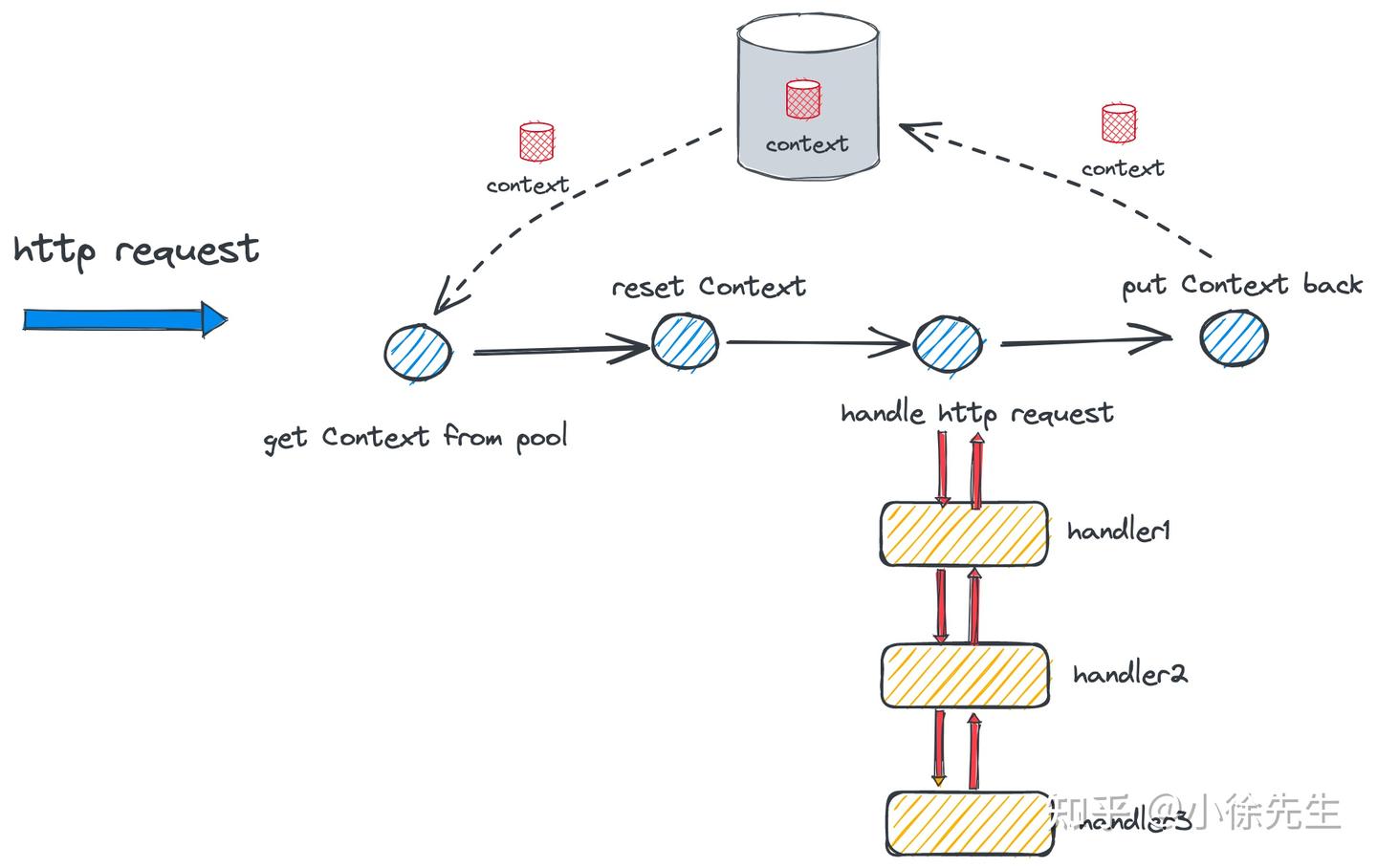
gin.Context 分配与回收的时机是在 gin.Engine 处理 http 请求的前后,位于 Engine.ServeHTTP 方法当中:
- 从池中获取 Context
- 重置 Context 的内容,使其成为一个空白的上下文
- 调用 Engine.handleHTTPRequest 方法处理 http 请求
- 请求处理完成后,将 Context 放回池中
1 | func (engine *Engine) ServeHTTP(w http.ResponseWriter, req *http.Request) { |
使用时机
(1)handlesChain 入口
在 Engine.handleHTTPRequest 方法处理请求时,会通过 path 从 methodTree 中获取到对应的 handlers 链,然后将 handlers 注入到 Context.handlers 中,然后启动 Context.Next 方法开启 handlers 链的遍历调用流程.
1 | func (engine *Engine) handleHTTPRequest(c *Context) { |
handlerschain遍历调用
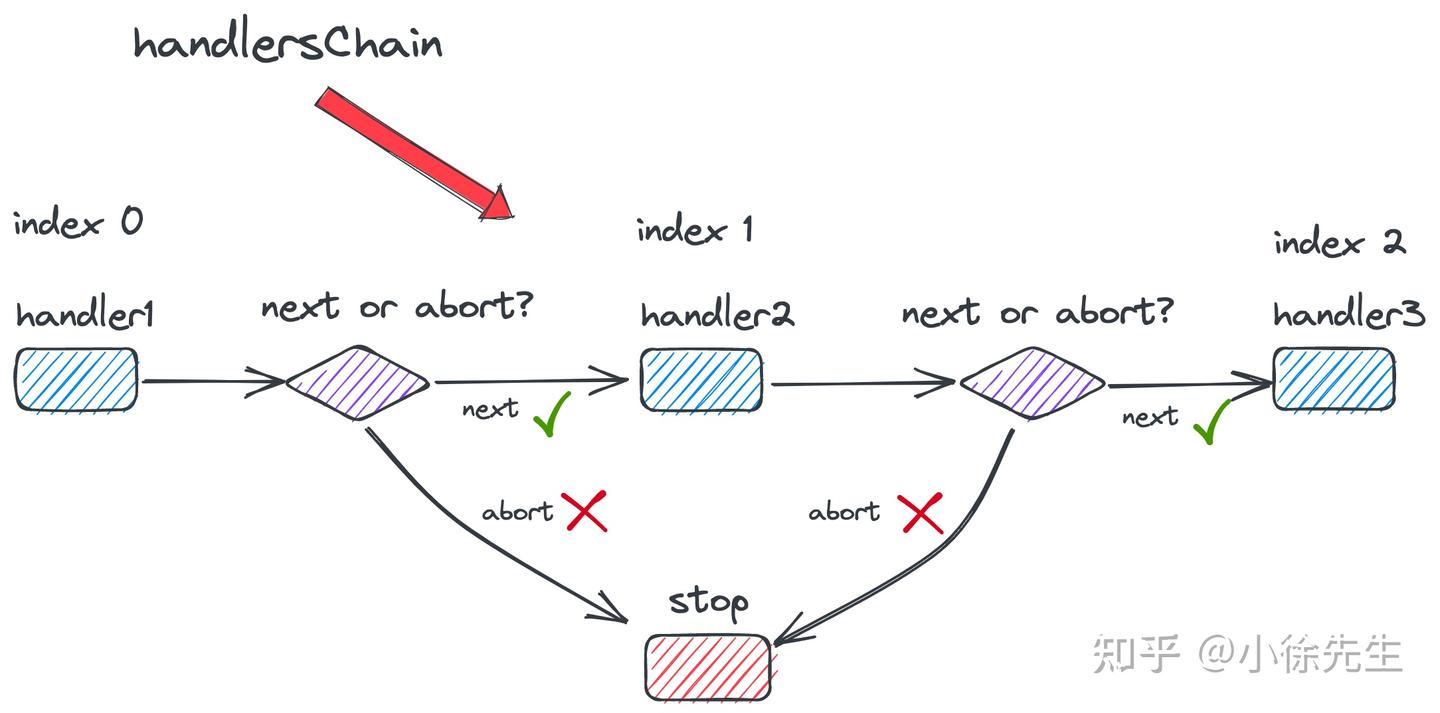
推进 handlers 链调用进度的方法正是 Context.Next. 可以看到其中以 Context.index 为索引,通过 for 循环依次调用 handlers 链中的 handler.(调用next会顺序执行其后的每个handler)
1 | func (c *Context) Next() { |
由于 Context 本身会暴露于调用链路中,因此用户可以在某个 handler 中通过手动调用 Context.Next 的方式来打断当前 handler 的执行流程,提前进入下一个 handler 的处理中,此时本质上是一个方法压栈调用的行为,因此在后置位 handlers 链全部处理完成后,最终会回到压栈前的位置,执行当前 handler 剩余部分的代码逻辑.
结合下面的代码示例来说,用户可以在某个 handler 中,于调用 Context.Next 方法的前后分别声明前处理逻辑和后处理逻辑,这里的“前”和“后”相对的是后置位的所有 handler 而言.
1 | func myHandleFunc(c *gin.Context){ |
此外,用户可以在某个 handler 中通过调用 Context.Abort 方法实现 handlers 链路的提前熔断.
其实现原理是将 Context.index 设置为一个过载值 63,导致 Next 流程直接终止. 这是因为 handlers 链的长度必须小于 63,否则在注册时就会直接 panic. 因此在 Context.Next 方法中,一旦 index 被设为 63,则必然大于整条 handlers 链的长度,for 循环便会提前终止.
1 | const abortIndex int8 = 63 |
总结
- gin 将 Engine 作为 http.Handler 的实现类进行注入,从而融入 Golang net/http 标准库的框架之内
- gin 中基于 handler 链的方式实现中间件和处理函数的协调使用
- gin 中基于压缩前缀树的方式作为路由树的数据结构,对应于 9 种 http 方法共有 9 棵树
- gin 中基于 gin.Context 作为一次 http 请求贯穿整条 handler chain 的核心数据结构
- gin.Context 是一种会被频繁创建销毁的资源对象,因此使用对象池 sync.Pool 进行缓存复用

